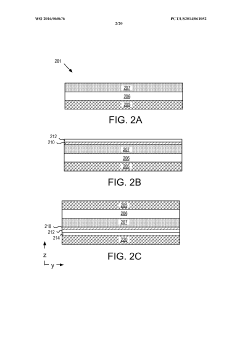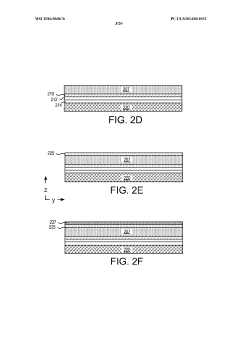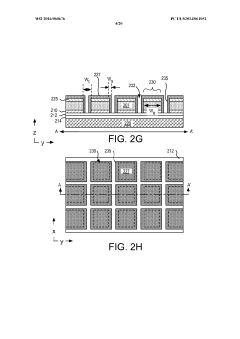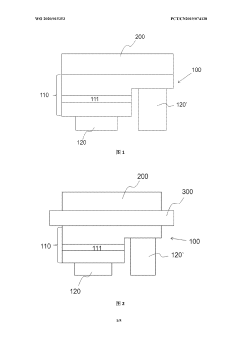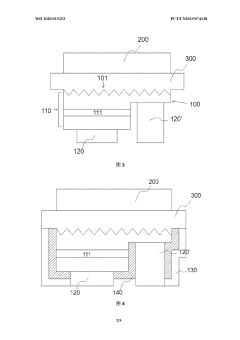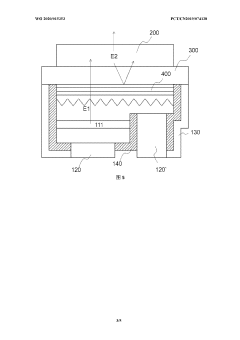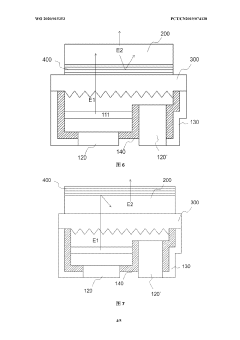ULED Technology Advances: Revolutionizing Display Quality
JUN 23, 20259 MIN READ
Generate Your Research Report Instantly with AI Agent
Patsnap Eureka helps you evaluate technical feasibility & market potential.
ULED Tech Evolution
ULED technology has undergone significant evolution since its inception, marking several key milestones in display technology advancement. The journey began with the introduction of LED-backlit LCD displays, which offered improved brightness and energy efficiency compared to traditional CCFL backlighting. This initial step paved the way for more sophisticated implementations of LED technology in displays.
The next major leap came with the development of direct LED backlighting, which allowed for more precise control over local dimming. This advancement significantly enhanced contrast ratios and black levels, addressing some of the limitations of edge-lit LED displays. As the technology progressed, manufacturers focused on increasing the number of local dimming zones, leading to more refined control over brightness across the display panel.
The introduction of Quantum Dot technology marked another crucial phase in ULED evolution. By incorporating a layer of quantum dots between the LED backlight and the LCD panel, displays could achieve a wider color gamut and improved color accuracy. This innovation brought ULED displays closer to the color reproduction capabilities of OLED technology while maintaining the brightness advantages of LED backlighting.
Recent years have seen the emergence of Mini-LED backlighting as a key advancement in ULED technology. By dramatically reducing the size of LED chips and increasing their number, Mini-LED displays offer superior local dimming capabilities, with thousands of dimming zones. This results in improved contrast, deeper blacks, and reduced blooming effects, narrowing the gap between LED-based displays and OLED technology.
The latest frontier in ULED evolution is the development of Micro-LED technology. Although still in its early stages for consumer applications, Micro-LED promises to combine the best aspects of LED and OLED technologies. By using microscopic LEDs as individual pixels, Micro-LED displays can potentially offer perfect blacks, infinite contrast ratios, and exceptional brightness, all while maintaining the longevity and burn-in resistance of traditional LED displays.
Throughout this evolution, ULED technology has consistently aimed to improve key display quality metrics such as brightness, contrast ratio, color accuracy, and energy efficiency. Each advancement has brought displays closer to achieving lifelike image quality, with the ultimate goal of creating visuals that are indistinguishable from reality. As research and development in this field continue, we can expect further refinements and potentially revolutionary breakthroughs that will continue to push the boundaries of display technology.
The next major leap came with the development of direct LED backlighting, which allowed for more precise control over local dimming. This advancement significantly enhanced contrast ratios and black levels, addressing some of the limitations of edge-lit LED displays. As the technology progressed, manufacturers focused on increasing the number of local dimming zones, leading to more refined control over brightness across the display panel.
The introduction of Quantum Dot technology marked another crucial phase in ULED evolution. By incorporating a layer of quantum dots between the LED backlight and the LCD panel, displays could achieve a wider color gamut and improved color accuracy. This innovation brought ULED displays closer to the color reproduction capabilities of OLED technology while maintaining the brightness advantages of LED backlighting.
Recent years have seen the emergence of Mini-LED backlighting as a key advancement in ULED technology. By dramatically reducing the size of LED chips and increasing their number, Mini-LED displays offer superior local dimming capabilities, with thousands of dimming zones. This results in improved contrast, deeper blacks, and reduced blooming effects, narrowing the gap between LED-based displays and OLED technology.
The latest frontier in ULED evolution is the development of Micro-LED technology. Although still in its early stages for consumer applications, Micro-LED promises to combine the best aspects of LED and OLED technologies. By using microscopic LEDs as individual pixels, Micro-LED displays can potentially offer perfect blacks, infinite contrast ratios, and exceptional brightness, all while maintaining the longevity and burn-in resistance of traditional LED displays.
Throughout this evolution, ULED technology has consistently aimed to improve key display quality metrics such as brightness, contrast ratio, color accuracy, and energy efficiency. Each advancement has brought displays closer to achieving lifelike image quality, with the ultimate goal of creating visuals that are indistinguishable from reality. As research and development in this field continue, we can expect further refinements and potentially revolutionary breakthroughs that will continue to push the boundaries of display technology.
Display Market Trends
The display market has been experiencing significant growth and transformation in recent years, driven by technological advancements and changing consumer preferences. The global display market size reached $148.4 billion in 2021 and is projected to grow at a CAGR of 7.2% from 2022 to 2030. This growth is primarily fueled by the increasing demand for high-quality displays across various sectors, including consumer electronics, automotive, healthcare, and industrial applications.
One of the key trends shaping the display market is the shift towards higher resolution and larger screen sizes. 4K and 8K displays are gaining traction, particularly in the premium television segment. The market share of 4K TVs has been steadily increasing, with global shipments reaching 213 million units in 2021. This trend is expected to continue as content providers offer more 4K and 8K content, driving consumer demand for higher resolution displays.
Another significant trend is the growing adoption of OLED (Organic Light-Emitting Diode) technology. OLED displays offer superior picture quality, deeper blacks, and wider viewing angles compared to traditional LCD displays. The OLED display market is projected to grow at a CAGR of 12.3% from 2022 to 2030, with smartphones and high-end TVs being the primary drivers of this growth.
Flexible and foldable displays are emerging as a new frontier in display technology. Major smartphone manufacturers have introduced foldable devices, and this trend is expected to expand to other product categories such as tablets and laptops. The market for flexible displays is forecasted to reach $44.7 billion by 2027, growing at a CAGR of 28.1% from 2022 to 2027.
In the automotive sector, the demand for advanced display technologies is rising rapidly. Head-up displays (HUDs), digital instrument clusters, and large infotainment screens are becoming standard features in modern vehicles. The automotive display market is expected to grow at a CAGR of 8.2% from 2022 to 2030, driven by the increasing integration of advanced driver assistance systems (ADAS) and autonomous driving technologies.
The COVID-19 pandemic has also influenced display market trends, accelerating the adoption of remote work and distance learning solutions. This has led to increased demand for monitors, laptops, and tablets with high-quality displays suitable for prolonged use. The work-from-home trend is expected to have a lasting impact on the display market, with a continued focus on ergonomic and eye-friendly display technologies.
One of the key trends shaping the display market is the shift towards higher resolution and larger screen sizes. 4K and 8K displays are gaining traction, particularly in the premium television segment. The market share of 4K TVs has been steadily increasing, with global shipments reaching 213 million units in 2021. This trend is expected to continue as content providers offer more 4K and 8K content, driving consumer demand for higher resolution displays.
Another significant trend is the growing adoption of OLED (Organic Light-Emitting Diode) technology. OLED displays offer superior picture quality, deeper blacks, and wider viewing angles compared to traditional LCD displays. The OLED display market is projected to grow at a CAGR of 12.3% from 2022 to 2030, with smartphones and high-end TVs being the primary drivers of this growth.
Flexible and foldable displays are emerging as a new frontier in display technology. Major smartphone manufacturers have introduced foldable devices, and this trend is expected to expand to other product categories such as tablets and laptops. The market for flexible displays is forecasted to reach $44.7 billion by 2027, growing at a CAGR of 28.1% from 2022 to 2027.
In the automotive sector, the demand for advanced display technologies is rising rapidly. Head-up displays (HUDs), digital instrument clusters, and large infotainment screens are becoming standard features in modern vehicles. The automotive display market is expected to grow at a CAGR of 8.2% from 2022 to 2030, driven by the increasing integration of advanced driver assistance systems (ADAS) and autonomous driving technologies.
The COVID-19 pandemic has also influenced display market trends, accelerating the adoption of remote work and distance learning solutions. This has led to increased demand for monitors, laptops, and tablets with high-quality displays suitable for prolonged use. The work-from-home trend is expected to have a lasting impact on the display market, with a continued focus on ergonomic and eye-friendly display technologies.
ULED Challenges
Despite the significant advancements in ULED technology, several challenges persist in its development and widespread adoption. One of the primary obstacles is the high production cost associated with ULED displays. The intricate manufacturing process, involving precise quantum dot placement and advanced color filtering techniques, contributes to elevated expenses, making ULED products less accessible to the mass market.
Another critical challenge lies in achieving consistent and uniform brightness across the entire display panel. As ULED technology relies on local dimming and precise control of individual LED zones, ensuring uniform illumination becomes increasingly complex, especially in larger screen sizes. This issue can lead to visible inconsistencies in image quality, particularly in scenes with high contrast ratios.
Power consumption remains a concern for ULED displays, especially in portable devices. While ULED offers improved energy efficiency compared to traditional LED technology, further optimizations are necessary to extend battery life in mobile applications without compromising display performance. Balancing power consumption with the demand for higher brightness and color accuracy presents an ongoing challenge for manufacturers.
Color accuracy and gamut representation pose additional hurdles for ULED technology. Although ULED displays can produce a wider color gamut than conventional LED panels, achieving precise color reproduction across the entire spectrum requires sophisticated color management systems and calibration techniques. Maintaining color accuracy over time and under varying ambient lighting conditions adds another layer of complexity to this challenge.
Durability and longevity of ULED displays are areas that demand continued attention. The quantum dot materials used in ULED technology can degrade over time, potentially leading to color shifts and reduced brightness. Developing more stable quantum dot formulations and implementing effective heat management solutions are crucial for ensuring the long-term reliability of ULED displays.
Manufacturing scalability presents a significant challenge for the ULED industry. As demand for larger screen sizes and higher resolutions increases, scaling up production while maintaining quality and yield rates becomes increasingly difficult. This challenge is particularly pronounced in the production of ultra-high-resolution displays for professional and commercial applications.
Lastly, the integration of ULED technology with emerging display features, such as flexible and transparent displays, poses unique engineering challenges. Adapting ULED's quantum dot technology to work effectively in flexible substrates or transparent panels requires innovative approaches to materials science and manufacturing processes, adding another layer of complexity to the development of next-generation display technologies.
Another critical challenge lies in achieving consistent and uniform brightness across the entire display panel. As ULED technology relies on local dimming and precise control of individual LED zones, ensuring uniform illumination becomes increasingly complex, especially in larger screen sizes. This issue can lead to visible inconsistencies in image quality, particularly in scenes with high contrast ratios.
Power consumption remains a concern for ULED displays, especially in portable devices. While ULED offers improved energy efficiency compared to traditional LED technology, further optimizations are necessary to extend battery life in mobile applications without compromising display performance. Balancing power consumption with the demand for higher brightness and color accuracy presents an ongoing challenge for manufacturers.
Color accuracy and gamut representation pose additional hurdles for ULED technology. Although ULED displays can produce a wider color gamut than conventional LED panels, achieving precise color reproduction across the entire spectrum requires sophisticated color management systems and calibration techniques. Maintaining color accuracy over time and under varying ambient lighting conditions adds another layer of complexity to this challenge.
Durability and longevity of ULED displays are areas that demand continued attention. The quantum dot materials used in ULED technology can degrade over time, potentially leading to color shifts and reduced brightness. Developing more stable quantum dot formulations and implementing effective heat management solutions are crucial for ensuring the long-term reliability of ULED displays.
Manufacturing scalability presents a significant challenge for the ULED industry. As demand for larger screen sizes and higher resolutions increases, scaling up production while maintaining quality and yield rates becomes increasingly difficult. This challenge is particularly pronounced in the production of ultra-high-resolution displays for professional and commercial applications.
Lastly, the integration of ULED technology with emerging display features, such as flexible and transparent displays, poses unique engineering challenges. Adapting ULED's quantum dot technology to work effectively in flexible substrates or transparent panels requires innovative approaches to materials science and manufacturing processes, adding another layer of complexity to the development of next-generation display technologies.
Current ULED Solutions
01 ULED display technology advancements
ULED (Ultra Light Emitting Diode) technology represents a significant advancement in display quality. It offers improved brightness, contrast, and color accuracy compared to traditional LED displays. ULED displays utilize advanced backlighting and local dimming techniques to enhance picture quality and energy efficiency.- ULED display panel structure: ULED technology incorporates advanced panel structures to enhance display quality. These structures may include specialized pixel arrangements, improved backlight systems, and optimized color filters to achieve better contrast, brightness, and color accuracy.
- Image processing algorithms for ULED: Advanced image processing algorithms are employed in ULED technology to improve display quality. These algorithms may include techniques for noise reduction, color enhancement, motion compensation, and dynamic contrast adjustment, resulting in sharper, more vibrant images.
- ULED backlight control technology: ULED displays utilize sophisticated backlight control technologies to enhance image quality. This may involve local dimming techniques, precise LED array management, and adaptive brightness control to improve contrast ratios and reduce power consumption while maintaining optimal picture quality.
- Color management in ULED displays: ULED technology incorporates advanced color management systems to deliver superior color accuracy and wider color gamuts. This may include the use of quantum dot technology, enhanced color filters, and sophisticated color calibration algorithms to produce more lifelike and vibrant images.
- ULED display driver innovations: Innovations in display driver technology contribute to improved ULED display quality. These may include advancements in timing controllers, voltage regulation, and signal processing to enhance image stability, reduce artifacts, and improve overall picture performance across various content types and viewing conditions.
02 Image processing and enhancement techniques
Various image processing algorithms and techniques are employed to improve ULED display quality. These include advanced color management systems, motion compensation, and noise reduction algorithms. Such techniques contribute to sharper images, smoother motion, and more accurate color reproduction in ULED displays.Expand Specific Solutions03 Display panel design and manufacturing
Innovations in display panel design and manufacturing processes play a crucial role in enhancing ULED display quality. This includes advancements in pixel structure, backplane technology, and materials used in the display stack. These improvements result in higher resolution, better viewing angles, and increased durability of ULED displays.Expand Specific Solutions04 Power management and energy efficiency
ULED displays incorporate advanced power management systems to optimize energy consumption while maintaining high display quality. This includes adaptive brightness control, selective pixel illumination, and efficient driver circuits. These features contribute to longer battery life in portable devices and reduced power consumption in larger displays.Expand Specific Solutions05 Integration with other display technologies
ULED technology is often combined with other display innovations to further enhance quality. This includes integration with quantum dot technology for wider color gamut, high dynamic range (HDR) implementation for improved contrast, and advanced refresh rate management for smoother motion. These combinations result in superior overall display performance.Expand Specific Solutions
Key ULED Manufacturers
The ULED technology market is in a dynamic growth phase, with significant potential for expansion. Major players like Samsung Display, LG Display, and TCL China Star Optoelectronics are driving innovation in this sector. The market size is expected to grow substantially as ULED technology offers superior display quality and energy efficiency. Technologically, ULED is advancing rapidly, with companies like Intel and Sharp contributing to its development. The technology's maturity varies among players, with some like Samsung and LG at the forefront, while others like Tianma Microelectronics and Appotronics are making strides in specific applications. Overall, the competitive landscape is characterized by intense R&D efforts and strategic partnerships to gain market share in this promising display technology.
Samsung Display Co., Ltd.
Technical Solution: Samsung Display has developed advanced ULED (Ultra LED) technology, which combines Quantum Dot (QD) technology with traditional LED backlighting. This hybrid approach allows for enhanced color accuracy, improved brightness, and better energy efficiency. The company's ULED panels utilize a specialized color filter and light-guiding structure to achieve wider color gamut and higher peak brightness levels compared to conventional LED displays. Additionally, Samsung has implemented local dimming techniques to improve contrast ratios and reduce blooming effects in dark scenes.
Strengths: Superior color accuracy and brightness, energy efficiency, and improved contrast ratios. Weaknesses: Potentially higher production costs and complexity in manufacturing process.
TCL China Star Optoelectronics Technology Co., Ltd.
Technical Solution: TCL CSOT has introduced its own version of ULED technology, focusing on enhancing the performance of traditional LED displays. Their approach involves using a combination of quantum dot technology and advanced local dimming algorithms. The company's ULED panels feature a high number of local dimming zones, allowing for more precise control over backlight intensity. TCL CSOT has also developed a proprietary light-guiding film that helps to reduce light leakage and improve overall picture quality. Furthermore, they have implemented AI-driven image processing to optimize content display in real-time.
Strengths: High number of local dimming zones, reduced light leakage, and AI-enhanced image processing. Weaknesses: Potential for increased power consumption due to complex backlighting system.
ULED Core Patents
Microled display & assembly
PatentWO2016060676A1
Innovation
- A method for fabricating and assembling crystalline LED elements involves wafer-level processing, thin film transfer, and controlled release techniques to form a source substrate with dielectric spacers and anchors, enabling the scalable integration of micron-scale LED elements into a display assembly.
Micro light emitting device and display thereof
PatentWO2020015353A1
Innovation
- Using a micro-light-emitting diode structure with a transparent adhesive layer, the blue/green light is converted into red light through photon conversion technology, the AlInGaP-based quantum well layer is used to achieve efficient photon conversion, and anti-reflection and anti-reflection are set on the micro-light-emitting diode. The film layer and light reflective layer optimize the light emission efficiency.
Energy Efficiency
Energy efficiency is a critical aspect of ULED (Ultra Light Emitting Diode) technology, contributing significantly to its revolutionary impact on display quality. ULED displays have made substantial strides in reducing power consumption while maintaining exceptional visual performance.
One of the key factors driving energy efficiency in ULED technology is the use of advanced local dimming techniques. By precisely controlling the backlight in specific zones, ULED displays can achieve deeper blacks and higher contrast ratios while minimizing power usage. This localized dimming approach allows for more efficient energy distribution across the display panel.
The implementation of quantum dot technology in ULED displays has further enhanced energy efficiency. Quantum dots enable the production of more vibrant and accurate colors with less energy input. This results in displays that can achieve higher color gamut coverage while consuming less power compared to traditional LED displays.
ULED technology also incorporates sophisticated power management systems. These systems dynamically adjust the display's brightness and contrast based on ambient lighting conditions and content being displayed. This adaptive approach ensures optimal viewing experience while minimizing unnecessary power consumption.
The development of more efficient LED drivers has played a crucial role in improving the overall energy efficiency of ULED displays. These advanced drivers provide better voltage regulation and current control, reducing power losses and heat generation. As a result, ULED displays can operate at lower temperatures, further contributing to energy savings and prolonged lifespan.
Recent advancements in ULED panel design have focused on optimizing light transmission and reducing internal reflections. By improving the optical properties of display components, manufacturers have been able to achieve higher luminance levels with lower power input. This has led to significant improvements in energy efficiency without compromising on display brightness or quality.
The integration of AI-powered algorithms in ULED displays has introduced another layer of energy optimization. These algorithms analyze content in real-time and adjust display parameters to minimize power consumption while maintaining optimal image quality. This intelligent approach to energy management represents a significant leap forward in display technology efficiency.
As ULED technology continues to evolve, researchers are exploring novel materials and structures to further enhance energy efficiency. This includes the development of more efficient phosphors, advanced optical films, and innovative pixel architectures. These ongoing efforts promise to push the boundaries of display energy efficiency even further, solidifying ULED's position as a game-changing technology in the display industry.
One of the key factors driving energy efficiency in ULED technology is the use of advanced local dimming techniques. By precisely controlling the backlight in specific zones, ULED displays can achieve deeper blacks and higher contrast ratios while minimizing power usage. This localized dimming approach allows for more efficient energy distribution across the display panel.
The implementation of quantum dot technology in ULED displays has further enhanced energy efficiency. Quantum dots enable the production of more vibrant and accurate colors with less energy input. This results in displays that can achieve higher color gamut coverage while consuming less power compared to traditional LED displays.
ULED technology also incorporates sophisticated power management systems. These systems dynamically adjust the display's brightness and contrast based on ambient lighting conditions and content being displayed. This adaptive approach ensures optimal viewing experience while minimizing unnecessary power consumption.
The development of more efficient LED drivers has played a crucial role in improving the overall energy efficiency of ULED displays. These advanced drivers provide better voltage regulation and current control, reducing power losses and heat generation. As a result, ULED displays can operate at lower temperatures, further contributing to energy savings and prolonged lifespan.
Recent advancements in ULED panel design have focused on optimizing light transmission and reducing internal reflections. By improving the optical properties of display components, manufacturers have been able to achieve higher luminance levels with lower power input. This has led to significant improvements in energy efficiency without compromising on display brightness or quality.
The integration of AI-powered algorithms in ULED displays has introduced another layer of energy optimization. These algorithms analyze content in real-time and adjust display parameters to minimize power consumption while maintaining optimal image quality. This intelligent approach to energy management represents a significant leap forward in display technology efficiency.
As ULED technology continues to evolve, researchers are exploring novel materials and structures to further enhance energy efficiency. This includes the development of more efficient phosphors, advanced optical films, and innovative pixel architectures. These ongoing efforts promise to push the boundaries of display energy efficiency even further, solidifying ULED's position as a game-changing technology in the display industry.
ULED Supply Chain
The ULED supply chain plays a crucial role in the advancement and widespread adoption of Ultra Light Emitting Diode (ULED) technology. This innovative display technology relies on a complex network of suppliers, manufacturers, and distributors to bring high-quality products to market.
At the core of the ULED supply chain are the raw material suppliers. These companies provide essential components such as semiconductor materials, rare earth elements, and specialized chemicals required for ULED production. The quality and consistency of these materials directly impact the performance and longevity of ULED displays.
Panel manufacturers form the next critical link in the chain. These companies utilize advanced manufacturing processes to produce ULED panels, integrating the raw materials and components into functional display units. The manufacturing process involves precision engineering and quality control measures to ensure optimal performance and reliability.
Component suppliers also play a vital role in the ULED ecosystem. They provide various elements such as drivers, controllers, and power management systems that are essential for the operation of ULED displays. The integration of these components significantly influences the overall efficiency and functionality of the final product.
Display module assemblers take the ULED panels and integrate them with other necessary components to create complete display modules. These modules are then supplied to original equipment manufacturers (OEMs) who incorporate them into various consumer electronics and professional display products.
The distribution network forms another crucial aspect of the ULED supply chain. Distributors and retailers play a significant role in making ULED products accessible to end-users, both in consumer and commercial markets. They also provide valuable feedback to manufacturers about market trends and consumer preferences.
Research and development institutions, while not directly involved in the production process, contribute significantly to the ULED supply chain. Their ongoing research efforts drive innovation in materials, manufacturing processes, and display technologies, continuously pushing the boundaries of what ULED technology can achieve.
The ULED supply chain is also influenced by regulatory bodies and industry standards organizations. These entities establish guidelines and certifications that ensure the quality, safety, and environmental sustainability of ULED products throughout the supply chain.
As ULED technology continues to evolve, the supply chain is expected to become more sophisticated and efficient. Advancements in automation, artificial intelligence, and data analytics are likely to streamline production processes and improve supply chain management, ultimately leading to more affordable and higher-quality ULED displays for consumers and businesses alike.
At the core of the ULED supply chain are the raw material suppliers. These companies provide essential components such as semiconductor materials, rare earth elements, and specialized chemicals required for ULED production. The quality and consistency of these materials directly impact the performance and longevity of ULED displays.
Panel manufacturers form the next critical link in the chain. These companies utilize advanced manufacturing processes to produce ULED panels, integrating the raw materials and components into functional display units. The manufacturing process involves precision engineering and quality control measures to ensure optimal performance and reliability.
Component suppliers also play a vital role in the ULED ecosystem. They provide various elements such as drivers, controllers, and power management systems that are essential for the operation of ULED displays. The integration of these components significantly influences the overall efficiency and functionality of the final product.
Display module assemblers take the ULED panels and integrate them with other necessary components to create complete display modules. These modules are then supplied to original equipment manufacturers (OEMs) who incorporate them into various consumer electronics and professional display products.
The distribution network forms another crucial aspect of the ULED supply chain. Distributors and retailers play a significant role in making ULED products accessible to end-users, both in consumer and commercial markets. They also provide valuable feedback to manufacturers about market trends and consumer preferences.
Research and development institutions, while not directly involved in the production process, contribute significantly to the ULED supply chain. Their ongoing research efforts drive innovation in materials, manufacturing processes, and display technologies, continuously pushing the boundaries of what ULED technology can achieve.
The ULED supply chain is also influenced by regulatory bodies and industry standards organizations. These entities establish guidelines and certifications that ensure the quality, safety, and environmental sustainability of ULED products throughout the supply chain.
As ULED technology continues to evolve, the supply chain is expected to become more sophisticated and efficient. Advancements in automation, artificial intelligence, and data analytics are likely to streamline production processes and improve supply chain management, ultimately leading to more affordable and higher-quality ULED displays for consumers and businesses alike.
Unlock deeper insights with Patsnap Eureka Quick Research — get a full tech report to explore trends and direct your research. Try now!
Generate Your Research Report Instantly with AI Agent
Supercharge your innovation with Patsnap Eureka AI Agent Platform!

